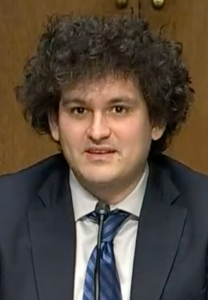
In my previous post, I outlined some of the possible explanations for spectacular business failures such as the recent collapse of the FTX crypto exchange. Which is the most plausible explanation?
The Evidence So Far.
Let us look at “the first rough draft” of FTX’s history and let us try to place the information revealed to date into the four different templates. Of course, it very well may be that more than one template helps to explain the collapse of FTX.
Fraud. The argument that fraud took place at FTX is simple. People who gave their assets to FTX were apparently promised that it would not be lent out by the exchange. FTX was to be a custodian of their assets. Yet their assets apparently were lent out. According to Reuters, as much as $10 billion may have been lent out to Alameda Research, the hedge fund supposedly run (very poorly) by SBF’s sometime mistress Caroline Ellison. That would seem to be criminal.
Thus, Count One of the U.S. Attorney’s criminal complaints says: “Bankman-Fried agreed with others to defraud customers of FTX.com by misappropriating those customers’ deposits and using those deposits to pay expenses and debts of Alameda Research, Bankman-Fried’s proprietary hedge fund, and to make investments.” The man now charged with sorting through the rubble at FTX, John Ray III, a 63-year-old insolvency attorney (who, coincidentally, oversaw the post-wreckage sale of Enron’s assets), described the cause of FTX’s collapse as follows: “This is just old-fashioned embezzlement. This is just taking money from customers and using it for your own purposes.” If that is in fact the story of FTX, no new regulations are needed.
Negligence. Samuel Bankman-Fried, immediately following FTX’s bankruptcy, told the New York Times that he had lost control of the company’s operations because he was distracted by his other projects. “Had I been a bit more concentrated on what I was doing, I would have been able to be more thorough. That would have allowed me to catch what was going on on the risk side.”[1] But the lack of financial oversight at FTX went well beyond the CEO’s personal distractions.

Consider: Enron’s Board of Directors was much criticized in post-mortems on many grounds, from its deference to CEO Ken Lay, to its failure to grill subordinate executives, to its willingness to waive conflict-of-interest rules. FTX had no real board of directors at all; the nominal board consisted of SBF and two of his employees, and they held no meetings. Similarly, Enron’s Chief Finance Officer, Andy Fastow, was much criticized for his Rube-Goldberg accounting structures and for his extensive self-dealing. FTX did not even have its own accounting department. Self-dealing? In one instance, SBF was both the issuer and recipient of a loan. [2]
In his 30-page report on FTX, John Ray wrote: “I have over 40 years of legal and restructuring experience. I have been the Chief Restructuring Officer or Chief Executive Officer in several of the largest corporate failures in history…. Never in my career have I seen such a complete failure of corporate controls and such a complete absence of trustworthy financial information as occurred here.”[3] This degree of financial negligence seems easily within the scope of current laws punishing corporate misfeasance.
Mistakes. But perhaps the bottom-line of this story is just that the people in charge of FTX screwed up. Crypto-currency is a new field of finance. The people involved with FTX were undoubtedly intelligent (SBF has a degree in physics from MIT), but they were mostly young. John Ray described them as “a small group of grossly inexperienced, unsophisticated individuals.”[4] One month before FTX’s troubles became public knowledge, short-seller Marc Cohodes was warning (in obscene and slashing terms) against trusting the firm. And one of his chief questions was: “Who taught this guy the ropes?” Who is SBF’s mentor? Yes, SBF is smart. Yes, his parents are smart (professors at Stanford Law). But Cohodes said he couldn’t find anybody in SBF’s background who had served as his mentor in the art of trading.
Corporate Culture. So, there is reason to believe that the collapse of FTX is attributable to bad decisions, negligence, and fraud. But one cannot help sensing, when reading about the fall of FTX, that its failure was also caused by something in the very spirit of the place. This was a company whose executives had no desire to follow the “best practices” for business success laid down by bourgeois capitalism between 1700 and 1950.
Again, those “best practices” of bourgeois capitalism might be summarized as: Don’t mix business and politics. Be forthright with counterparties. Understand the value of what you are producing. The unifying theme of those three precepts is: Make sure you are obtaining profits that are earned, and only profits that are earned—not profits based on rent-seeking, market hype, or daydreams. On all three counts, the evidence seems to show, FTX (like Enron) was a fundamentally contra-capitalist company. And the contra-capitalist soul of FTX may well prove to be the ultimate explanation of its implosion.
Conclusion
Business failures such as FTX are bound to be exploited by anti-capitalist theorists and politicians, just as Enron was. National Review columnist Andrew C. McCarthy has already warned about this. McCarthy, formerly chief assistant in the U.S. Attorney’s office that has now indicted SBF, recently wrote: “The administration and Democrats have been biding their time, waiting for some financial catastrophe that can be stoked into a groundswell of support for thoroughgoing crypto regulation. In Bankman-Fried’s alleged FTX scam, they obviously perceive such an opportunity.”[5] That is why pro-capitalist theorists must understand thoroughly what happened at FTX: to prevent its collapse from becoming an excuse for legislation irrelevant to the underlying causes.
But once pro-capitalists understand how the FTX bankruptcy occurred, they can use that information as their own intellectual ammunition. After all, one of two things is going to be true about it (although both may be true): (1) The failure resulted from violations of capitalist law—bans on fraud and negligence—and thus demonstrates the wisdom of the free-market’s guardrails. (2) The failure resulted from business misjudgments and thus serves once again to educate free-market participants—most particularly ordinary participants in the free market: small-scale consumers, savers, investors, and traders—about the need for knowledge and prudence.
The first point is easily made by pro-market advocates; the second is more difficult, because exercising “knowledge and prudence” in a free-market entails focusing on two very different attributes of companies: Achievement and Philosophy. The need to evaluate Corporate Achievement knowledgeably and prudently has been fairly well understood ever since Benjamin Graham and David Dodd published Security Analysis in 1934. But the need to evaluate Corporate Philosophy knowledgeably and prudently, and to avoid dealing with contra-capitalist companies, is only beginning to be understood. Perhaps FTX will serve as a stimulus to that understanding.
Roger Donway is a research assistant at the Institute for Energy Research and freelance editor and writer.
[1] Samuel Bankman-Fried, quoted in David Yaffe-Bellany, “How Sam Bankman-Fried’s Crypto Empire Collapsed,” New York Times, November 14, 2022.
[2] John J. Ray III, testimony, House Financial Services Committee, December 13, 2022. The quotation about self-dealing loans is available here, from the Washington Post via YouTube.
[3] In re: FTX Trading Ltd. et al., filed November 17, 2022, U.S. Bankruptcy Court for the District of Delaware, “Declaration of John J. Ray III in Support of Chapter 11 Petitions and First Day Pleadings,” p. 2.
[4] Marc Cohodes, interviewed by Keith McCullough, Hedgeye Investing Summit, Fall 2022, via YouTube, at 44:55.
[5] Andrew C. McCarthy, “Progressive Regulators Are Salivating over the Sam Bankman-Fried Scandal,” National Review Online (website), December 17, 2022.

Comments are closed.